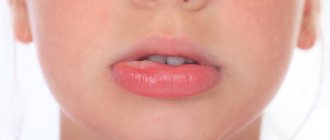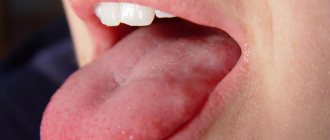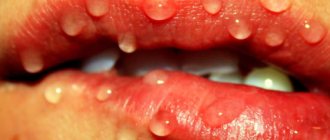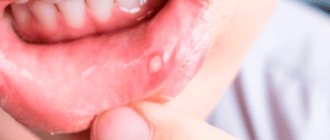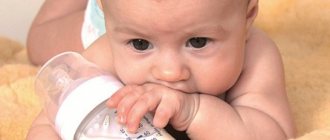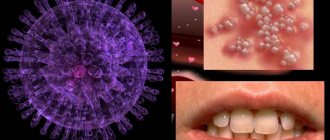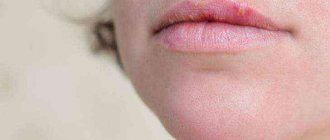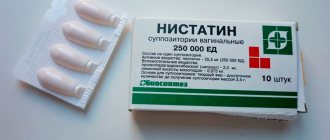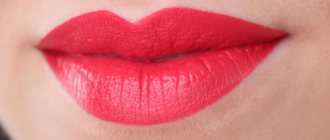Parents are different, some tend to treat a newly born child, and then an older baby, with a certain amount of sloppiness and irresponsibility, while others, on the contrary, surround their beloved child with excessive care and guardianship. It is the second category of mothers and fathers who are most often the first to notice a callus on the lip of a newborn, and as soon as they see this problem, they begin to look for the underlying causes of its appearance, and also invent methods for eliminating the “disease.” In today’s article you will learn what a “milk callus” is, why it appears in a child and whether you need to do something about it.
Attention! Danger! Or not?
Examining her baby once again after bathing, feeding, or simply during his quiet sleep, the mother may discover that “something” has appeared on his upper lip. Some will see a watery blister in the very center of the sponge, some will see a small hardened growth, and some will see a dried piece of skin that has already peeled off. If the baby is not bothered by this phenomenon, the neoplasm does not ooze ichor, is not inflamed or red, there is no need to worry or worry.
A callus on the lip of a newborn is a normal physiological condition that occurs in the vast majority of infants and even has a specific medical name.
In what cases should you consult a doctor?
If your baby cries, becomes irritated when feeding, or develops a fever, you should immediately consult a doctor. Diagnostics will help determine the disease.
After the examination, the following characteristics will exclude the factor of a dangerous callus on the lip of a baby:
- the callus is smooth, round, does not hurt;
- no redness, blisters, or white spots are observed.
With stomatitis, the following manifestations are displayed: oval-shaped ulcers, grayish or white background;
- cover the inside of the mucous membrane of the lips and cheeks;
- their localization may be under the tongue, on the palate,
- pain appears;
- The baby doesn't sleep well, doesn't eat, and throws away the nipple.
We suggest you read about Why it burns in the throat. burning sensation - the causes of what disease? heat in the larynx
All manifestations are accompanied by fever, and lethargy appears.
For thrush:
- the oral cavity is coated with a coating in the form of cheesy masses;
- ulcerated skin forms underneath;
- When sucking, the baby experiences pain.
With herpes, a callus may appear on the 14th day after the baby is born. The symptoms accompanying the formation are as follows:
- temperature rises;
- drowsiness appears;
- bubbles can spread throughout the body;
- muscle tone decreases;
- a convulsive state is indicated.
If such signs occur, you should immediately consult a pediatrician; the herpes virus is dangerous for young children.
"Milk" callus
In reference books on caring for infants, this problem, which is not a problem at all, is designated as a milk callus. This condition can manifest itself in a child from the first days after birth, or maybe even after a few months - it all depends on several associated factors and the characteristics of the baby himself.
A callus on a newborn's lip appears as a result of the intense work that the baby needs to do just to eat. Active and frequent sucking causes the delicate skin to become injured and swell. The callus may even become watery and become a little rougher over time. Unlike the corns and chafing that adults are used to, which they get when putting on an uncomfortable pair of shoes or after working in the garden without gloves, a “milk” callus does not bring any inconvenience to the baby. Because of her, he will not eat less, much less give up the breast or bottle.
All questions about the appearance and ways to help newborns with a callus on the lip
With the birth of your baby, you acquire a number of new obligations, for example, responsibility for his health. And therefore, when you see a new pimple or swelling on your child’s body, you begin to worry, even when your baby is completely calm. A callus on the upper lip of a newborn may raise a number of related questions in your mind.
How to tell if a bubble of fluid is a callus
You find a bubble filled with liquid on your baby’s upper lip; most likely it’s a callus. During the sucking period, a newborn intensively works with his mouth, and since his skin is still very delicate and not accustomed to work, this is a completely natural process.
If your baby behaves calmly and does not act up every time he tries to feed him, then there really is a callus on his lip. This means you should calm down, because the baby feels your psychological state very strongly. And sometimes it is precisely this that can cause a child to cry.
It is important to know! The appearance of a callus on a newborn's lip can be confirmed by its appearance. It should be whitish in color with clear liquid inside.
All other modifications of the callus that do not fit the description will require closer attention and study from you.
Why might a baby develop a callus?
Breastfeeding is a new and unknown process for you, just as it is for a newborn baby. But, oddly enough, it is he who can provoke the appearance of a number of ailments in both, if certain rules are not followed. Rubbing delicate sponges against the mother's breast or silicone nipple can cause a callus in the baby.
For information on how to properly breastfeed a newborn, read the article: Correctly attaching a baby to the breast>>>
The appearance of a watery blister can be noticed as early as the second week. But you shouldn’t rush and say that a newborn has a callus if you find a bubble on the lip with a yellowish liquid, and there is pronounced redness around it - this is certainly not from sucking. The reasons for its appearance can be caused by the following diseases:
You can get rid of it yourself by disinfecting all objects that the newborn comes into contact with and maintaining your own hygiene. A soda solution for wiping the mouth will help you alleviate the baby's condition. Manipulation should be carried out 4 to 8 times a day.
But as for stomatitis, this disease requires examination by a pediatrician and the prescription of complex treatment.
Should we panic?
Remember, in matters of upbringing and health of children, panic is a bad friend and ally. Before you do anything, you should decide whether it is necessary and how much better your actions will make the newborn.
A real milk callus, which so often attracts the attention of parents, does not bring any discomfort to the baby. It may accompany the entire period of breastfeeding or appear periodically.
The main thing to remember:
- Do not open the bladder and release liquid from it, so as not to cause an infection;
- If the callus bursts during the feeding period, it should be treated with hydrogen peroxide; What other medications should be in the First Aid Kit for a newborn?>>>
- To prevent calluses from being a sign of another disease, maintain personal hygiene before each feeding of your child.
How to distinguish a callus in a newborn from herpes
Infection with herpes in a newborn can occur in only two ways - in utero and during labor. In these cases, the presence of pathology cannot be excluded.
It is important to know that herpes on the lip of a newborn can appear in the same way as a callus - on the 14th day of his independent life (Read about what changes happen to a baby in the first days of life: What should a child be able to do at 1 month?>>>. But This infectious disease is accompanied by a number of additional symptoms:
- increased body temperature;
- watery blisters may appear on other parts of the body;
- the child becomes drowsy;
- muscle tone may be reduced;
- development of a convulsive state.
Herpes is very dangerous for a young child. Delayed or incorrect treatment can take the life of your newborn baby. To learn about how to keep your child healthy and protected from infections, watch our course: Healthy Child, workshop for mom>>>
Remember! The baby should not be capricious or show signs of anxiety if he really has a callus.
The health of the newborn certainly requires your close attention, but you should not sound the alarm unnecessarily.
Source: https://uroki4mam.ru/mozol-na-gube-u-novorozhdennogo
Correct and incorrect breasts
Suspicious mothers and compassionate grandmothers tend to twist facts and make a problem out of nothing. Often, having identified a callus on the lip of a newborn during breastfeeding, parents and their relatives believe that it arose due to improper breast structure or the baby’s inability to take the nipple.
In fact, if the mother does not experience discomfort during feeding, the baby latch onto the breast well and is able to eat, then there are no problems with feeding. The only nuance that is worth noting is that with the now popular method of feeding on demand, and not by the hour, the baby is attached to the mother’s “boob” quite often. If he stays near the nurse for a long time (more than the prescribed 15-20 minutes), then the likelihood that a “milk” callus will appear on his lip increases significantly.
Will a bottle save you from calluses?
This, however, does not mean that it is worth limiting the baby’s sucking; moreover, pediatricians do not recommend weaning the baby or switching to mixed feeding before he is 6 months old. A callus on the lip of a newborn with artificial feeding occurs as often as in those babies who eat mother's milk.
If this problem greatly worries parents or the child experiences certain difficulties while eating, you can try changing the nipple on the bottle. The silicone nozzle is more durable and hygienic, but traditional latex is softer and more delicate to the touch, and many children like the tactile sensations after touching it more.
Are we going to treat?
So, if you and your baby have had to deal with such an unpleasant phenomenon as a callus on the lip of a newborn, first of all, do not panic. If in doubt and if you want not to leave everything to chance, contact your child’s attending physician; after assessing the situation, he will suggest the correct algorithm of action.
In the vast majority of cases, no treatment will be needed, but delicate skin will not be harmed at all by light moisturizing and nutrition; it is best to use natural olive oil, it will soften the callus and prevent a rough and rough crust from forming in its place.
Some doctors recommend cauterizing a callus on a newborn’s lip with an antiseptic (iodine, brilliant green, furatsilin). Treatment with such means is a controversial and controversial method, because they are quite aggressive in their effects and can cause burns, especially on such a delicate area of the body as the lips. If a blister has burst, the best treatment for the wound is hydrogen peroxide; it will disinfect and dry the hole without further injuring the skin.
Causes and methods of treating calluses on the upper lip in a child
A callus on the lip of a newborn is a defect that appears due to intense breastfeeding. The phenomenon is natural if the baby does not have enough milk during feeding. It is important to distinguish between the types of skin pathologies in order to provide timely help to the baby.
Causes and symptoms of appearance in newborns
The baby actively works with its lips when sucking on its mother's breast. Its skin is still very thin and tender. As a result of intensive work, the child's upper lip rubs and a callus forms.
The appearance of a watery pimple in the middle of the upper lip of a baby can be detected 7-14 days after birth. This can happen due to a lack of milk in the breast, a natural need for sucking. This callus will go away over time.
If the mother finds a bubble with yellow liquid and there is redness around it, the cause may be:
- herpesvirus;
- thrush;
- stomatitis.
Diseases worry the baby. He refuses to eat, cries, and a white coating appears in his mouth. You should contact your pediatrician.
If the baby is calm and does not cry when feeding, a callus has formed on the sponge. In this case, adults better stop being nervous.
The difference between calluses and other skin diseases
A wet callus on the upper lip of a baby has several differences:
- placed clearly in the middle of the upper lip along the edge of the mucous membrane;
- the defect itself is round in shape;
- white bubble with liquid, diameter 5-6 mm.
If there is no pressure, the formation resolves; a new, healthy area grows under the skin.
If the callus is dry, the crust will be dense. A thick top layer appears. In this situation, its color is close to pale pink with a subtle yellowness. When touching a wet or dry callus, the child will not feel discomfort, there is no pain. Other pathologies that do not correspond to the description pose a danger to the baby.
With thrush and stomatitis, the callus may have a yellow, gray, or white background. The edges of the formation may turn red and the tissues may swell. The baby develops increased salivation.
With herpes, the callus is accompanied by swelling; there may be several blisters at the edges of the mouth. There is a burning sensation and redness around the lesion.
Rules for caring for calluses
Calluses on the lips of a baby, formed during sucking, do not require special care. If you reduce the load and apply it correctly to the chest, it will disappear without intervention.
It is forbidden to pierce the growth or tear off the exfoliated area of skin. Such actions will lead to infection.
If the blister bursts on its own, the following care must be taken:
- Take a cotton swab.
- Dip in 3% hydrogen peroxide solution.
- Gently wipe the affected area.
If the formation occurs due to thrush, you can carry out the following manipulations:
- Soak a sterile cloth in a mixture of baking soda and warm water.
- Disinfect nipples and objects with which there is contact (toys, bottles, nozzles, breasts).
- Lightly wipe away plaque from the mouth. Perhaps the mucous membrane will bleed.
- Repeat the manipulation 4-7 times a day.
The method will allow the baby to feel relief on the second day.
If formations appear due to herpes or stomatitis, an examination by a specialist is necessary. Some doctors advise cauterizing the callus with iodine, brilliant green, or furatsilin solution. This treatment should be used under the supervision of a therapist so as not to cause a burn on the baby’s delicate skin.
Feeding rules and prevention of occurrence
During the first months of life, a child’s desire to suck appears every 1 hour during the day, and 3-4 times at night. When breastfeeding, the mother gives breast at the baby's request. With the breast in his mouth, he relaxes, gets the right dose of milk, and falls asleep. Sucking gives him a feeling of peace.
When feeding on demand, nipples and bottles are not used to avoid loss of breast milk. Feeding by the hour when the mother does not have her own milk or there is a deficiency. The mixture is taken every 3 hours. With such feeding, there may be problems with lactation and lack of milk.
Prevention of formations - apply natural olive and vegetable oil to the baby’s delicate skin. The products will help soften the callus and rough crust.
If there are difficulties with artificial feeding:
- the hole in the nipple should be made wider;
- change the nipple to a silicone nozzle. Latex is tactilely more pleasant.
In what cases can it appear in an adult?
The appearance of blisters on the lower or upper lip can occur as a result of illness or improper care of the skin on the lips. The cause of the pathology may be the bad habit of biting your lips.
There are several more reasons.
| Cause | Signs | How to treat | Prevention |
| Weathering | A peeling crust will form. | Scrub, clean your lips with a toothbrush, use hygienic lipstick, and a mask with honey. | Protect from sun rays, nourish the dermis, do not bite your lips in the wind. |
| Herpes | Several blisters are accompanied by swelling and burning, then an ulcer forms that is difficult to heal. Fever, muscle weakness. | Buy Acyclovir, Zovirax ointment at the pharmacy. The main antiviral treatment and immunomodulatory drugs are used. | Avoid kissing, take vitamin supplements, and do not contact anyone who carries the virus. |
| Stomatitis | Inflammatory processes on the oral mucosa, covering the lips, provoke the appearance of cracks, infections, and allergies. Pain, discomfort when eating. | Consultation with a doctor, taking antifungal drugs and antibiotics. | Use your own hygiene products, drink vitamin complexes. |
At different ages, the origin of the callus may be different. In infants, it can be triggered by intense sucking of breast milk. In an adult, the habit of biting lips. Pathology occurs as a result of various dangerous diseases: stomatitis, herpes, thrush.
In children, if the callus is marked on the upper lip and looks like a small bubble with clear liquid, the formation will go away naturally.
Other symptoms will require medical attention to avoid complications. In order to prevent the appearance of formations from bottles, pediatricians advise breastfeeding your baby for up to 6 months.
The article has been verified by the editors Link to the main publication
articles:
(1 5,00 of 5) Loading...
Didn't find suitable advice?
or see all questions...
Source: https://ProGuby.ru/bolezni/mozol-na-gube
Don't miss the real problem
Do not forget that the oral mucosa is one of the first barriers that various types of viruses and infections have to overcome on their way into the human body. Young children are a special risk group; they put everything in their mouths that comes to hand. It is not always possible to surround a child with ideal sterility and cleanliness, especially since this should not be done, because sooner or later he will find himself in completely different conditions, and an unprepared immune system will not be able to cope with the siege of pathogenic organisms.
The most common problems that can arise in children of the first year of life directly in the mouth are thrush and stomatitis. The first disease is the formation of a whitish coating on the mucous membranes; in advanced cases, small ulcers can be found underneath it.
Stomatitis has different symptoms: the mouth, and sometimes the lips, become covered with blisters filled with whitish liquid, and redness and swelling of the tissues are visualized around the blisters. The disease itself is often accompanied by high fever. It is very important not to write off this infection as a normal callus on the lip of a newborn. Photos of “milk” calluses and stomatitis will help you avoid mistakes, as well as take adequate measures when the baby needs real treatment.
